手势语
- 格式:doc
- 大小:107.00 KB
- 文档页数:20
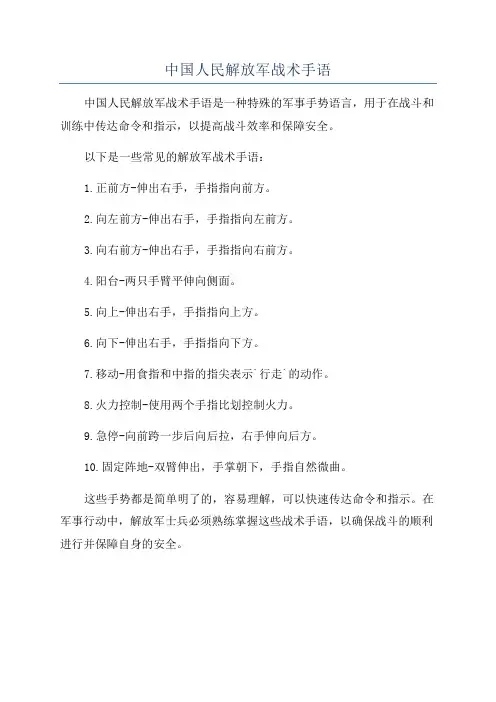
中国人民解放军战术手语
中国人民解放军战术手语是一种特殊的军事手势语言,用于在战斗和训练中传达命令和指示,以提高战斗效率和保障安全。
以下是一些常见的解放军战术手语:
1.正前方-伸出右手,手指指向前方。
2.向左前方-伸出右手,手指指向左前方。
3.向右前方-伸出右手,手指指向右前方。
4.阳台-两只手臂平伸向侧面。
5.向上-伸出右手,手指指向上方。
6.向下-伸出右手,手指指向下方。
7.移动-用食指和中指的指尖表示`行走`的动作。
8.火力控制-使用两个手指比划控制火力。
9.急停-向前跨一步后向后拉,右手伸向后方。
10.固定阵地-双臂伸出,手掌朝下,手指自然微曲。
这些手势都是简单明了的,容易理解,可以快速传达命令和指示。
在军事行动中,解放军士兵必须熟练掌握这些战术手语,以确保战斗的顺利进行并保障自身的安全。

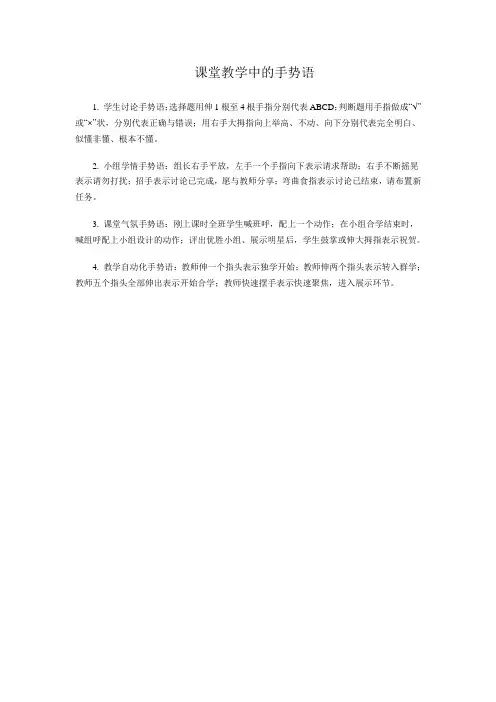
课堂教学中的手势语
1. 学生讨论手势语:选择题用伸1根至4根手指分别代表ABCD;判断题用手指做成“√”或“×”状,分别代表正确与错误;用右手大拇指向上举高、不动、向下分别代表完全明白、似懂非懂、根本不懂。
2. 小组学情手势语:组长右手平放,左手一个手指向下表示请求帮助;右手不断摇晃表示请勿打扰;招手表示讨论已完成,愿与教师分享;弯曲食指表示讨论已结束,请布置新任务。
3. 课堂气氛手势语:刚上课时全班学生喊班呼,配上一个动作;在小组合学结束时,喊组呼配上小组设计的动作;评出优胜小组、展示明星后,学生鼓掌或伸大拇指表示祝贺。
4. 教学自动化手势语:教师伸一个指头表示独学开始;教师伸两个指头表示转入群学;教师五个指头全部伸出表示开始合学;教师快速摆手表示快速聚焦,进入展示环节。
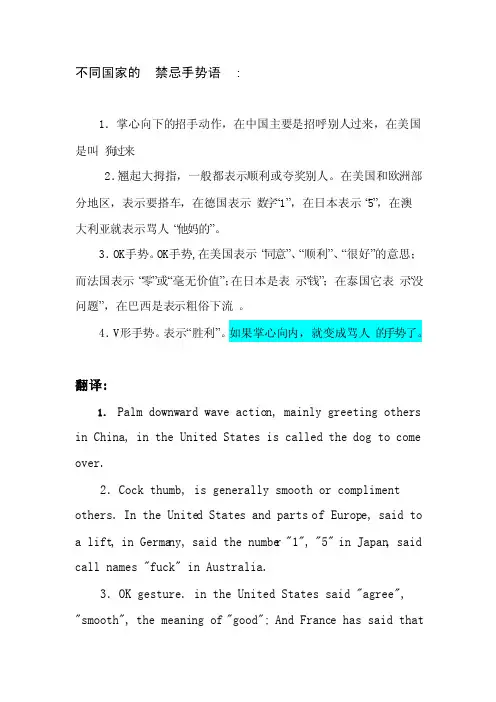
不同国家的禁忌手势语:1.掌心向下的招手动作,在中国主要是招呼别人过来,在美国是叫狗过来2.翘起大拇指,一般都表示顺利或夸奖别人。
在美国和欧洲部分地区,表示要搭车,在德国表示数字“1”,在日本表示“5”,在澳大利亚就表示骂人“他妈的”。
3.OK手势。
OK手势,在美国表示“同意”、“顺利”、“很好”的意思;而法国表示“零”或“毫无价值”;在日本是表示“钱”;在泰国它表示“没问题”,在巴西是表示粗俗下流。
4.V形手势。
表示“胜利”。
如果掌心向内,就变成骂人的手势了。
翻译:1.Palm downwa rd wave action, mainly greeti ng others in China, in the United States is called the dog to come over.2.Cock thumb, is genera lly smooth or compli mentothers. In the United States and partsof Europe, said to a lift, in German y, said the number"1", "5" in Japan,said call names"fuck" in Austra lia.3.OK gestur e. in the United States said "agree", "smooth", the meanin g of "good"; And France has said that"zero" or "worthl ess"; In Japanis said "money"; In Thaila nd it said "no proble m", said is ribald ry in Brazil. 4. V-shaped gestur e. Said "victor y". If the palm inward, they became abusiv e gestur es.。
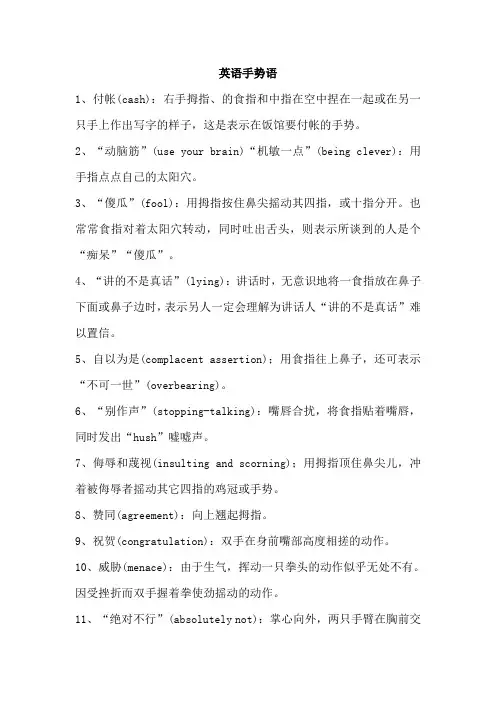
英语手势语1、付帐(cash):右手拇指、的食指和中指在空中捏在一起或在另一只手上作出写字的样子,这是表示在饭馆要付帐的手势。
2、“动脑筋”(use your brain)“机敏一点”(being clever):用手指点点自己的太阳穴。
3、“傻瓜”(fool):用拇指按住鼻尖摇动其四指,或十指分开。
也常常食指对着太阳穴转动,同时吐出舌头,则表示所谈到的人是个“痴呆”“傻瓜”。
4、“讲的不是真话”(lying):讲话时,无意识地将一食指放在鼻子下面或鼻子边时,表示另人一定会理解为讲话人“讲的不是真话”难以置信。
5、自以为是(complacent assertion);用食指往上鼻子,还可表示“不可一世”(overbearing)。
6、“别作声”(stopping-talking):嘴唇合扰,将食指贴着嘴唇,同时发出“hush”嘘嘘声。
7、侮辱和蔑视(insulting and scorning);用拇指顶住鼻尖儿,冲着被侮辱者摇动其它四指的鸡冠或手势。
8、赞同(agreement):向上翘起拇指。
9、祝贺(congratulation):双手在身前嘴部高度相搓的动作。
10、威胁(menace):由于生气,挥动一只拳头的动作似乎无处不有。
因受挫折而双手握着拳使劲摇动的动作。
11、“绝对不行”(absolutely not):掌心向外,两只手臂在胸前交叉,然后再张开至相距一米左右。
12、“完了”(that‘s all):两臂在腰部交叉,然后再向下,向身体两侧伸出。
13、“害羞”(shame):双臂伸直,向下交叉,两掌反握,同时脸转向一侧。
14、打招呼(greeting):英语国家人在路上打招呼,常常要拿帽子表示致意。
现一般已化为抬一下帽子,甚至只是摸一下帽沿。
15、高兴激动(happiness and excitement):双手握拳向上举起,前后频频用力摇动。
16、愤怒、急燥(anger and anxiousness):两手臂在身体两侧张开,双手握拳,怒目而视。
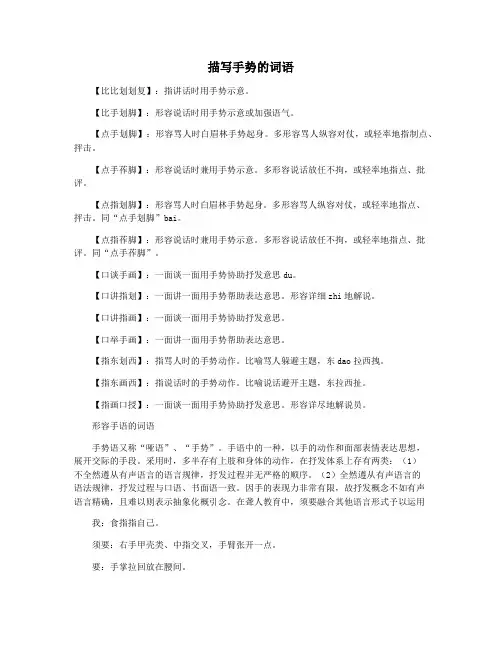
描写手势的词语【比比划划复】:指讲话时用手势示意。
【比手划脚】:形容说话时用手势示意或加强语气。
【点手划脚】:形容骂人时白眉林手势起身。
多形容骂人纵容对仗,或轻率地指制点、抨击。
【点手莋脚】:形容说话时兼用手势示意。
多形容说话放任不拘,或轻率地指点、批评。
【点指划脚】:形容骂人时白眉林手势起身。
多形容骂人纵容对仗,或轻率地指点、抨击。
同“点手划脚”bai。
【点指莋脚】:形容说话时兼用手势示意。
多形容说话放任不拘,或轻率地指点、批评。
同“点手莋脚”。
【口谈手画】:一面谈一面用手势协助抒发意思du。
【口讲指划】:一面讲一面用手势帮助表达意思。
形容详细zhi地解说。
【口讲指画】:一面谈一面用手势协助抒发意思。
【口举手画】:一面讲一面用手势帮助表达意思。
【指东划西】:指骂人时的手势动作。
比喻骂人躲避主题,东dao拉西拽。
【指东画西】:指说话时的手势动作。
比喻说话避开主题,东拉西扯。
【指画口授】:一面谈一面用手势协助抒发意思。
形容详尽地解说员。
形容手语的词语手势语又称“哑语”、“手势”。
手语中的一种,以手的动作和面部表情表达思想,展开交际的手段。
采用时,多半存有上肢和身体的动作,在抒发体系上存有两类:(1)不全然遵从有声语言的语言规律,抒发过程并无严格的顺序。
(2)全然遵从有声语言的语法规律,抒发过程与口语、书面语一致。
因手的表现力非常有限,故抒发概念不如有声语言精确,且难以则表示抽象化概引念。
在聋人教育中,须要融合其他语言形式予以运用我:食指指自己。
须要:右手甲壳类、中指交叉,手臂张开一点。
要:手掌拉回放在腰间。
你:食指指对方。
干净利落:形容没有多余的东西.令人爽心悦目.也形容动作熟练、敏捷准确.慌手慌脚:形容动作KMH.轻手轻脚:手脚动作很轻,使没有响声.三下五除二:珠算口诀.形容处事及动作干脆利索.一举一动:指人的每一个动作.眼明手快:脑子科东俄,动作灵巧.指手画脚:指说话时做出各种动作.形容说话时放肆或得意忘形.指东画西:指骂人时的手势动作.比喻骂人躲避主题,东拉西扯.左右开弓:左右手都能射箭.比喻两只手轮流做同一动作或同时做几项工作.形色仓皇:动作匆忙,神色惊慌失措.举止不凡:举动不平凡.形容人的行为动作非同一般,与众不同.爱不释手碍手碍脚碍足碍手别出手眼不龟手药别具手眼白手成家比手划脚白手空拳白手起家搏手无策白手兴家不择手段措手不及搓手顿脚出手得卢搓手顿足垂手而得垂手可得触手可及赤手空拳重手累足触手生春寸铁在手读不舍手倒持手板大打出手跌脚绊手丹青妙手大手大脚点手莋脚点手划脚断手续玉得手应心毒手尊前毒手尊拳大显身手得心应手顿足搓手倒执手版额手称庆额手称颂额手相庆反手可得蝮蛇螫手,壮士解腕翻手为云,覆手为雨翻手云覆手雨负手之歌革面敛手拱手而降拱手让人拱手听命高抬贵手高下其手高下在手回春妙手行家里手河梁携手后手不接慌手慌脚慌手忙脚狠心辣手枷脰械手脚忙手乱举手加额皲手茧足挤手捏脚举手投足举手相庆假手于人举手之劳敛手待毙捩手覆羹两手空空楞手楞脚敛手屏足鹿死谁手妙手丹青妙手回春妙手空空毛手毛脚妙手偶得目送手挥目治手营捏脚捏手蹑脚蹑手拿手好戏捏手捏脚蹑手蹑脚蹑手蹑足拍手称快胼手胝足胼胝手足拳不离手,曲不离口棋逢对手棋逢敌手棋高一着,缚手缚脚七脚八手强将手下无弱兵亲如手足七手八脚轻手蹑脚轻手轻脚轻手软脚情同手足七郤八手七足八手强中更有强中手跷足抗手强中自有强中手人多手杂热可炙手如手如足人手一册如左右手手不释卷手不释书书不释手手不停挥手不停毫手不应心手到病除手到拈来手到拿来手到擒来手高手低手高眼低手挥目送手脚干净手脚无措手疾眼快手急眼快手零脚碎水来伸手,饭来张口手忙脚乱十目所视,十手所指手胼足胝三拳不敌四手伸手不见五指束手待毙束手待死束手缚脚束手就毙束手就缚束手就困束手就擒束手就禽螫手解腕束手就殪束手旁观顺手牵羊束手束脚缩手缩脚束手束足束手听命束手无策束手无措束手无计束手无术束手自毙束手坐视十手争指手无寸刃手无寸铁手无缚鸡之力手舞足蹈手下留情上下其手遂心应手手眼通天手足重茧手足胼胝手足失措手足无措手足异处手足之情手泽之遗抬脚动手脱手弹丸唾手可得唾手可取弹丸脱手无所措手无所错小儿无所措手肢污手垢面握手言欢心慈手软心狠手毒心狠手辣心辣手狠心灵手巧心慕手追心摹手追揎拳裸手洗手不干洗手奉公洗手奉职信手拈来袖手旁观小手小脚心手相忘心手相应雄文大手心闲手敏先下手为强悬崖撒手眼高手低眼高手生眼急手快眼疾手快眼尖手快一举手之劳衣来伸手,饭来张口眼明手快一手包办摇手触禁一手独拍,虽疾无声右手画圆,左手画方游手好闲以手加额一手托天游手偷闲引手投足一手一脚一手一足一手遮天易于反手一朝权在手,便把令来行足蹈手舞足茧手胝斫轮老手着手成春指手点脚指手顿脚指手画脚指手划脚炙手可热札手舞脚支手舞脚举手投足:一使劲,一动脚。

世界各国的手势语手势语(sign language )是体态语的一种。
体态语(body language )包括眼神、走路姿势、站立的姿势以及手势等等。
体态语十分丰富,可以表达各种思想感情,并且不同的文化有着不同的体态语。
下面是一些常见的手势语在不同文化中的含义:1. 翘大拇指(thumb )。
在中国,翘大拇指表示“好”,用来称赞对方干得不错、了不起、高明、这个意思在世界上许多国家都是一样的。
英美人伸大拇指,向上翘,意为“ It's good. ”或“ It's OK. ”。
伸大拇指,向下翘,意为“ It's bad. ”或“ I don't agree it. ”。
但是在一些国家还有另外的意思。
比如,在日本,它还表示“男人”、“你的父亲”、“最高”;在韩国,还表示“首领”、“自己的父亲”、“部长”和“队长”;在澳大利亚、美国、墨西哥、荷兰等国,则表示“祈祷命运”;到了法国、印度,在拦路搭车时可以使用这一手势;在尼日利亚,它又表示对远方亲人的问候。
此外,一些国家还用这一手势指责对方“胡扯”。
2. 将拇指和食指(forefinger )弯曲合成圆圈,手心向前。
这个手势在美国表示“ OK”;在日本表示钱;在拉丁美洲则表示下流低级的动作。
3. 用食指点别人。
这在欧美国家是很不礼貌的责骂人的动作。
英美人把大拇指和食指组成圆,其余三指伸直,意为“ Excellent. ”4. 伸出食指。
在美国表示让对方稍等;在法国表示请求对方回答问题;在缅甸表示请求,拜托;在新加坡表示最重要的;在澳大利亚则表示“请再来一杯啤酒”。
5. 伸出食指和中指(middle finger )做V 字状。
“ V ”是英文victory 和法文victore (胜利)的第一个字母,故在英国、法国、捷克等国此手势含有“胜利”之意。
但在塞尔维亚语中这一手势代表“英雄气概”,在荷兰语中则代表“自由”。
6. 食指弯曲:这一手势在中国表示“ 9 ”;在日本表示小偷,特别是那些专门在商店里偷窃的人及其偷窃行为;在泰国、新加坡、马来西亚表示死亡;在墨西哥则表示钱或询问价格及数量的多少。
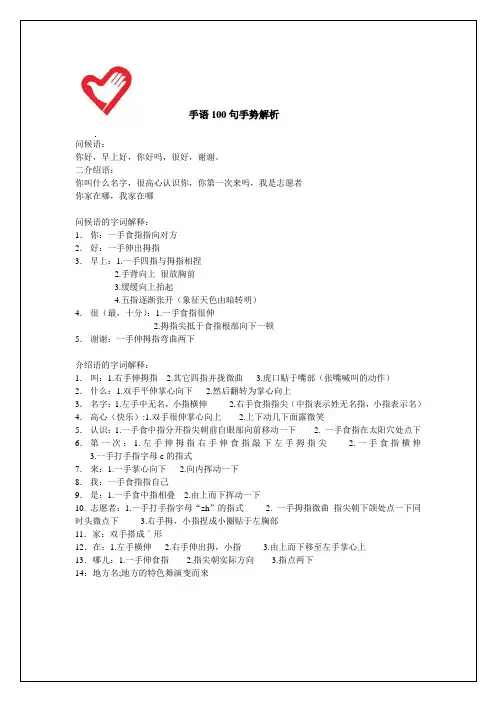
手语100句手势解析
问候语:
你好,早上好,你好吗,很好,谢谢。
二介绍语:
你叫什么名字,很高心认识你,你第一次来吗,我是志愿者
你家在哪,我家在哪
问候语的字词解释:
1.你:一手食指指向对方
2.好:一手伸出拇指
3.早上:1.一手四指与拇指相捏
2.手背向上很放胸前
3.缓缓向上抬起
4.五指逐渐张开(象征天色由暗转明)
4.很(最,十分):1.一手食指很伸
2.拇指尖抵于食指根部向下一顿
5.谢谢:一手伸拇指弯曲两下
介绍语的字词解释:
1.叫:1.右手伸拇指 2.其它四指并拢微曲 3.虎口贴于嘴部(张嘴喊叫的动作)
2.什么:1.双手平伸掌心向下 2.然后翻转为掌心向上
3.名字:1.左手中无名,小指横伸 2.右手食指指尖(中指表示姓无名指,小指表示名)4.高心(快乐):1.双手很伸掌心向上 2.上下动几下面露微笑
5.认识:1.一手食中指分开指尖朝前自眼部向前移动一下 2. 一手食指在太阳穴处点下6.第一次:1.左手伸拇指右手伸食指敲下左手拇指尖 2.一手食指横伸
3.一手打手指字母c的指式
7.来:1.一手掌心向下 2.向内挥动一下
8.我:一手食指指自己
9.是:1.一手食中指相叠 2.由上而下挥动一下
10. 志愿者:1.一手打手指字母“zh”的指式 2. 一手拇指微曲指尖朝下颌处点一下同时头微点下 3.右手拇,小指捏成小圈贴于左胸部
11.家:双手搭成^形
12.在:1.左手横伸 2.右手伸出拇,小指 3.由上而下移至左手掌心上
13.哪儿:1.一手伸食指 2.指尖朝实际方向 3.指点两下
14:地方名;地方的特色舞演变而来。
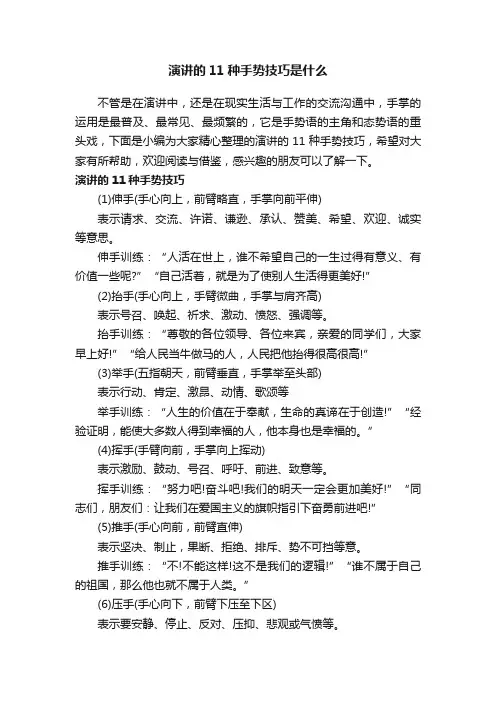
演讲的11种手势技巧是什么不管是在演讲中,还是在现实生活与工作的交流沟通中,手掌的运用是最普及、最常见、最频繁的,它是手势语的主角和态势语的重头戏,下面是小编为大家精心整理的演讲的11种手势技巧,希望对大家有所帮助,欢迎阅读与借鉴,感兴趣的朋友可以了解一下。
演讲的11种手势技巧(1)伸手(手心向上,前臂略直,手掌向前平伸)表示请求、交流、许诺、谦逊、承认、赞美、希望、欢迎、诚实等意思。
伸手训练:“人活在世上,谁不希望自己的一生过得有意义、有价值一些呢?”“自己活着,就是为了使别人生活得更美好!”(2)抬手(手心向上,手臂微曲,手掌与肩齐高)表示号召、唤起、祈求、激动、愤怒、强调等。
抬手训练:“尊敬的各位领导、各位来宾,亲爱的同学们,大家早上好!”“给人民当牛做马的人,人民把他抬得很高很高!”(3)举手(五指朝天,前臂垂直,手掌举至头部)表示行动、肯定、激昂、动情、歌颂等举手训练:“人生的价值在于奉献,生命的真谛在于创造!”“经验证明,能使大多数人得到幸福的人,他本身也是幸福的。
”(4)挥手(手臂向前,手掌向上挥动)表示激励、鼓动、号召、呼吁、前进、致意等。
挥手训练:“努力吧!奋斗吧!我们的明天一定会更加美好!”“同志们,朋友们:让我们在爱国主义的旗帜指引下奋勇前进吧!”(5)推手(手心向前,前臂直伸)表示坚决、制止,果断、拒绝、排斥、势不可挡等意。
推手训练:“不!不能这样!这不是我们的逻辑!”“谁不属于自己的祖国,那么他也就不属于人类。
”(6)压手(手心向下,前臂下压至下区)表示要安静、停止、反对、压抑、悲观或气愤等。
压手训练:“时间就是生命,无端地浪费别人的时间,其实是无异于谋财害命的。
”“谁若把金钱看得比荣誉还尊贵,谁就会从高贵降到低贱。
”(7)摆手(手心对外,前臂上举至中区上部)表示反感、蔑视、否认、失望、不屑一顾等。
摆手训练:“一个人的价值,应该看他贡献什么,而不应当看他取得什么。
”“凡在小事上对真理持轻率态度的人,在大事上也是不可信任的。

法国手势语
- 撅嘴、耸肩、摊手:表示质疑、否定、不确定,例如在表达“这不是我的错,我也没法子,我不知道,我很怀疑,我不太同意”等意思时使用。
- 皱眉,加甩手:表示某个故事或事件非常惨。
- 快速拍打左手手腕:表示该离开了,意思是“Barrons-nous. 走吧!”。
- 表情惊悚,手像龙虾:表示担心和害怕。
- 把拳头放在鼻子上转动:表示喝多了,喝醉了。
- 指着眼睛,拉下眼皮:表示不相信,这是一个相对礼貌的版本,相当于英文中的my butt,my ass。
- 把两指伸向鼻孔:表示这很容易,很简单,带点讽刺意味。
- 把手扫过头顶:表示“我受够了”。
需要注意的是,在使用法国手势语时,要注意文化差异和对方的理解,以避免产生误解或冒犯。
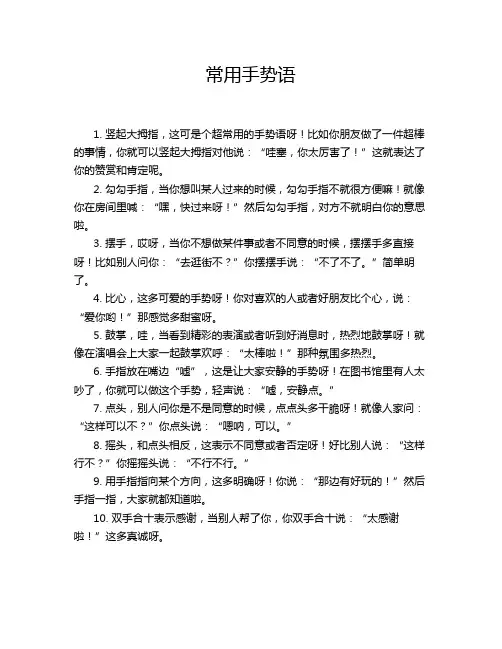
常用手势语
1. 竖起大拇指,这可是个超常用的手势语呀!比如你朋友做了一件超棒的事情,你就可以竖起大拇指对他说:“哇塞,你太厉害了!”这就表达了你的赞赏和肯定呢。
2. 勾勾手指,当你想叫某人过来的时候,勾勾手指不就很方便嘛!就像你在房间里喊:“嘿,快过来呀!”然后勾勾手指,对方不就明白你的意思啦。
3. 摆手,哎呀,当你不想做某件事或者不同意的时候,摆摆手多直接呀!比如别人问你:“去逛街不?”你摆摆手说:“不了不了。
”简单明了。
4. 比心,这多可爱的手势呀!你对喜欢的人或者好朋友比个心,说:“爱你哟!”那感觉多甜蜜呀。
5. 鼓掌,哇,当看到精彩的表演或者听到好消息时,热烈地鼓掌呀!就像在演唱会上大家一起鼓掌欢呼:“太棒啦!”那种氛围多热烈。
6. 手指放在嘴边“嘘”,这是让大家安静的手势呀!在图书馆里有人太吵了,你就可以做这个手势,轻声说:“嘘,安静点。
”
7. 点头,别人问你是不是同意的时候,点点头多干脆呀!就像人家问:“这样可以不?”你点头说:“嗯呐,可以。
”
8. 摇头,和点头相反,这表示不同意或者否定呀!好比别人说:“这样行不?”你摇摇头说:“不行不行。
”
9. 用手指指向某个方向,这多明确呀!你说:“那边有好玩的!”然后手指一指,大家就都知道啦。
10. 双手合十表示感谢,当别人帮了你,你双手合十说:“太感谢啦!”这多真诚呀。
我觉得这些常用手势语真的很有趣也很实用呀,能让我们的交流更加生动和丰富呢!。
常用手语及手势大全
1.所有:双手张开,手心向上伸出。
2.好:大拇指向上竖起来,其余手指握成拳头。
3.不好:大拇指向下指向下,其余手指握成拳头。
4.是的:两手手指交叉,食指与中指相叉;
5.否定:两手手指交叉,拇指与食指相叉;
6.没事:两手手指交叉,食指与中指、无名指相叉,拇指靠在手掌上。
7.爱:用手指如画一个大心。
8.飞吻:以嘴巴向对方吹吻,或者用食指画出心形。
9.非常感谢:两手手指张开,放在胸前,向前微微弯腰。
10.好久不见:两手握在一起,做“抱拳”的动作,眼睛逐渐向上看。
11.您好:右手肘部向上,手掌向外,左手喊声“您好”。
12.再见:右手向上,左手放在右手臂上。
13.抱抱:双手互相搂住,可以伴随着轻柔的拍背动作。
14.委屈:双手捂住眼睛,表示心里委屈。
15.快乐:一手捏着虚拟的香槟杯,用手指摆动,再做个“啪”的手势,表示庆祝快乐。
16.惊喜:两手张开,嘴巴大张,眼睛瞪大,表示惊讶和欣喜。
17.请进:一手放在心口处,另一手伸出请对方进入。
18.路过:一只手捏着拳头,表示经过这里。
19.向上:手臂伸直向上,手指向上指向天空。
20.向下:手臂伸直向下,手指向下指向地面。
演讲的手势语有哪些-演讲的手势运用常用的〔演讲〕手势语有这些:抬手(手心向上,手臂微曲,手掌与肩齐高)——表示号召、唤起、祈求、激动、愤慨、强调等;伸手(手心向上,前臂略直,手掌向前平伸)——表示请求、交流等。
一、演讲的手势语有哪些1、抬手(手心向上,手臂微曲,手掌与肩齐高)——表示号召、唤起、祈求、激动、愤慨、强调等。
抬手训练:“尊敬的各位领导、各位来宾,亲爱的同学们,大家早上好!〞2、伸手(手心向上,前臂略直,手掌向前平伸)——表示请求、交流、许诺、谦逊、承认、赞美、希望、欢迎、诚实等意思。
伸手训练:“人活在世上,谁不希望自己的一生过得有意义、有价值一些呢?〞3、举手(五指朝天,前臂垂直,手掌举至头部)——表示行动、肯定、激昂、动情、歌颂等。
4,挥手(手臂向前,手掌向上挥动)——表示鼓动、号召、呼吁、前进、致意等。
挥手训练:“努力吧!奋斗吧!我们的明天一定会更加美好!〞5、推手(手心向前,前臂直伸)——表示坚决、制止,果断、拒绝、排斥、势不可挡等意。
推手训练:“不!不能这样!这不是我们的逻辑!〞“谁不属于自己的“祖国,那么他也就不属于人类。
〞6、压手(手心向下,前臂下压至下区)——表示要宁静、停止、反对、压抑、悲观或气愤等。
压手训练:“时间就是生命,无端地浪费别人的时间,其实是无异于谋财害命的。
〞二、演讲的手势运用1、达情式手势。
其主要作用是表达感情的。
比如,表示愤慨时挥拳头,摊开双手表示没办法。
等等。
2、习惯手势。
任何一位演讲者都有一些只有他自己才有而别人没有的习惯性手势,且手势的含义不明确不固定,随着演讲内容的不同而体现不同的含义。
3、抒情手势。
此手势在演讲中运用频率最多。
比如:兴奋时拍手称快;恼怒时挥舞拳头;急曝时双手相搓;果断时猛力砍下。
抒情手势是一种抽象感情很强的手势。
4、比拟性手势。
是指演讲者为使听众对抽象事物有一种具体感、实在感,从而用手表示一些比较复杂的感情和比较抽象的概念。
手语基础(一)字词(二)句子1、我————一手食指指着自己。
2、你————一手食指指向对方。
3、他————一手食指指向侧方第三者。
4、我们————一手食指先指胸部,然后掌心向下,在胸前平行转一圈。
5、你们————一手食指先指向对方,然后掌心向下,在胸前平行转一圈。
6、他们———一手食指指向侧方第三者,然后掌心向下,在胸前平行转一圈。
7、自己————一手伸食指,指尖向上,贴于胸前。
8、大家————一手掌心向下,在胸前平行转一圈。
9、谁————一手伸食指,指尖向上,在背前前摇动。
10、男————一手直立,五指并拢在头侧自后向前挥动,以“短发”表示男子。
11、女(姑娘)——一手拇、食指捏耳垂,象征耳环,泛指妇女(凡女性均用此手势)。
12、小孩(少年、儿童)——一手平伸,掌心向下,在胸前向下微按(根据小孩、儿童、少年不同身高而决定手的高低)。
13、老人————①一手在下巴作理胡须动作,以长胡须来表示老。
②双手食指搭成“人”字形。
14、父亲(爸爸)————一手伸拇指贴在嘴唇上。
15、母亲(妈妈)————一手伸食指贴在嘴唇上。
16、哥哥————一手先伸中指贴于嘴唇上,再改伸掌直立,在头侧自前挥动,即“男”手语。
17、姐姐————一手先伸中指贴于嘴唇上,然后改以拇、食指捏耳垂。
18、妹妹————一手先伸小指贴于嘴唇上,再打“女”手势。
19、弟弟20、外祖父——①左手横伸,掌心向内,右手食指在左掌背外向下指。
②手指字母“Z”的指式。
③一手伸拇指贴在嘴唇上。
21、外祖母——①②同“外祖父”手势。
③一手伸食指贴在嘴唇上。
22、祖父——①手指字母“Z”的指式。
②一手伸拇指贴在嘴唇上。
23、祖母——①手指字母“Z”的指式。
②一手伸食指贴在嘴唇上24、同学——①一手伸食、中指,手背向上,在胸前平行挥动两下。
②双手伸掌,掌心向内赃物于胸前,如读书状。
25、朋友————双手伸拇指互碰几下,表示友谊。
26、工人————①一手食、中指与另一手食指搭成“工”字形。
祝贺词的手势一、毕业祝福的手势语下面是手语的具体动作示范丶第一套手语的意思是:老师,祝你快乐,健康,幸福。
老师:双手五指撮合,指尖相对,在胸前摇动几下,意即“传授”。
或者一手伸拇指贴于胸前。
祝:双手抱拳在胸前挥动,就像我们平时做恭喜恭喜的动作你:用一手的食指指对方。
快乐:双手五指并拢,指尖相对,手心向上,在胸前交替上下动几下。
健康:双手五指并拢,手背向外,指尖相对,从胸前向腹部由上往下移动,一边下移,一边握起四指,伸出拇指。
幸福:右手食指与中指相叠呈X形,指尖向上,手心向右,虎口向自己,按左——下——右的顺序绕一圈。
第二套手语的意思是:老师,谢谢你,我们爱你。
老师:双手五指撮合,指尖相对,在胸前摇动几下,意即“传授”。
或者一手伸拇指贴于胸前。
谢谢:一手伸出拇指,弯曲两下,表示向人感谢。
你:用一手的食指指对方。
我们:一手食指先指胸部,然后掌心向下,在胸前平行转一圈。
爱:一手轻轻抚摩另一手拇指指背,表示一种“怜爱”的感情。
你:用一手食指指向对方。
希望我的回答帮到你。
祝好!。
二、一些祝福的手语祝:双手抱拳在胸前挥动,就像我们平时做恭喜恭喜的动作你:用一手的食指指对方。
快乐:双手五指并拢,指尖相对,手心向上,在胸前交替上下动几下健康:双手五指并拢,手背向外,指尖相对,从胸前向腹部由上往下移动,一边下移,一边握起四指,伸出拇指幸福:右手食指与中指相叠呈X形,指尖向上,手心向右,虎口向自己,按左——下——右的顺序绕一圈。
女生的打法手语里没有,可以打女孩:先用右手拇食指捏住右耳垂,表示女性,然后手心向下,指尖向前放在身体右侧向下微微按一下,表示小孩子。
1到10标准手势1. 拇指竖起,这是一个表示“好”的手势,通常用于表达赞同或者肯定的意思。
当你对某件事情感到满意或者赞许时,可以用这个手势来表示你的态度。
2. 食指指向上方,这个手势通常用于表示“等一下”或者“我有话要说”。
当你想要引起别人的注意或者表示你有话要说时,可以用这个手势来示意。
3. 食指和中指比划,这是一个比较通用的手势,可以用来表示“等一会儿”、“不要”或者“停止”。
在不同的语境下,这个手势可以有不同的含义。
4. 大拇指竖起,这个手势通常用于表示“优秀”或者“干得好”。
在一些文化中,这个手势也可以表示“胜利”或者“成功”。
5. 食指和中指交叉,这个手势通常用于表示“好运”或者“幸运”。
在一些场合,人们也会用这个手势来祈求好运或者表示对他人的祝福。
6. 食指指向自己,这个手势通常用于表示“我”或者“我要”。
当你想要表达自己的意愿或者需求时,可以用这个手势来表示。
7. 食指和中指并拢,这个手势通常用于表示“一点也不”或者“不行”。
在一些情况下,这个手势也可以表示“不要”或者“拒绝”。
8. 食指和中指分开,这个手势通常用于表示“好的”或者“可以”。
当你同意或者接受某件事情时,可以用这个手势来表示你的态度。
9. 食指指向前方,这个手势通常用于表示“前进”或者“继续”。
在一些情况下,这个手势也可以表示“往前走”或者“前方有问题”。
10. 手掌打开,这个手势通常用于表示“停止”或者“放开”。
当你想要制止某件事情或者表示放弃时,可以用这个手势来表示你的意愿。
总的来说,手势是一种非常重要的交流方式,它可以帮助人们更好地表达自己的意愿和情感。
在日常生活中,我们可以通过学习和运用不同的手势来提高自己的交流能力,更好地与他人进行沟通和交流。
希望这篇文档对你有所帮助,谢谢阅读!。
演讲的手势语言在演讲中,演讲者正确而及时地使用手势,有助于说明问题、表明心迹、升华情感、感染听众,从而收到良好的演讲效果,今天小编给大家分享一些演讲的肢体语言,希望对大家有所帮助。
演讲的手势语言一:表情用手势表达思想感情,使情感表达得真切、具体、形象,渲染作用很大。
如高兴时拍拍手,悲痛时捶胸,愤怒时挥舞拳头,悔恨时敲前额。
翘起拇指或鼓掌表示钦佩、赞扬;双手摊开表示真诚、无可奈何;手摸后脑表示尴尬或不好意思;挥手用力下砍表示坚决果断的决心或态度;见面时伸手,手掌向前伸,手心向上,胳膊微曲,与别人紧握表示友好和欢迎等。
表情性手势是演说人内在情感和态度的自然流露,鲜明突出、生动形象地表明自己的观点、情感,能给听众留下深刻的印象。
如西方政治家在一些盛大的群众集会上演讲之前,面对热烈鼓掌的广大听众,他们往往会用双手举过双肩,手心向外,向听众摇摆,表示对听众的欢迎致以礼貌性的谢意,以及恳请听众可以停止鼓掌,以便他开始演讲。
表情性手势语在演讲中运用得最多,其表现方式和涵义也极为丰富。
1917 年5月14日,列宁在演讲台上,时而来回走动,时而有力地挥动双臂,时而俯身,那激昂的声调,适当的动作,给人以无尽的感染力。
对无产阶级革命必胜的信心,对人民的爱,对敌人的蔑视,是他演讲时激情和力量的源泉。
因而在演讲中,他总是那么热情洋溢、精神振奋。
列宁的演讲,列宁的激情,没有丝毫的矫揉造作的成份。
他不以美丽的词藻来哗众取宠,不以无病呻吟来博取同情,而是以自己坚强的信念和执着的追求以及对是非功过的正确认识来激励、鼓舞群众,号召他们起来斗争。
演讲的手势语言二:达意用手势表明具体内容,直接指示了演讲者要说的事物,或者表达特定含义。
如招手表示过来;连连摆手表示反对或不要;挥手表示再见或叫人走开;用手指自己表示谈论自己及其有关的事等。
又如,1942年延安整风运动中,毛泽东曾多次为党政军干部作演讲,他把内容归纳为一、二、三、四或甲、乙、丙、丁,并且边讲边用右手扳着左手指,一个一个地数,其手势语含义直截了当。
Gestures: Body Language and Nonverbal CommunicationBy Gary ImaiGesturesAn IntroductionDo we expect other cultures to adopt our customs or are we willing to adopt theirs? This might translate to how business or even foreign relations are to be conducted. Do we compromise or force others peoples to deal only on our terms? We may not have time to hear a language , but taking time to learn the "signals" is a powerful communicator.As the global village continues to shrink and cultures collide, it is essential for all of us to become more sensitive, more aware, and more observant to the myriad motions, gestures, and body language that surround us each day. And as many of us cross over cultural borders, it would be fitting for us to respect, learn, and understand more about the effective, yet powerful "silent language" of gestures.The world is a giddy montage of vivid gestures- traffic police, street vendors, expressway drivers, teachers, children on playground, athletes with their exuberant hugging, clenched fists and "high fives." People all over the world use their hands, heads, and bodies to communicate expressively. Without gestures, our world would be static and colorless. The social anthropologist Edward T. Hall claims 60 percent of all our communication is nonverbal. In that case, how can we possibly communicate with one another without gestures?Gestures and body language communicate as effectively as words- maybe even more effectively. We use gestures daily, almost instinctively, from beckoning to a waiter, or punctuating a business presentation with visual signals to airport ground attendants guiding an airline pilot into the jetway or a parent using a whole dictionary of gestures to teach (or preach to) a child. Gestures are woven inextricably in to our social lives, but also that the "vocabulary" of gestures, can be at once informative and entertaining... but also dangerous. Gestures can be menacing (two drivers on a freeway), warm (an open-armed welcome). instructive(a police man giving road directions), or even sensuous (the liquid movement of a Hawaiian hula dancer).Bear in mind that the following gestures are in general use, but there may always be exceptions. In recent years, Western and contemporary values and ideas have become more popular and have either influenced, altered, and even replaced, some of the more traditional gestures,understanding human behavior is tricky stuff. No two people behave in precisely the same way. Nor do people from the same culture all perform exactly the same gestures and body language uniformly. For almost any gestures there will probably be a minority within a given nationality who might say "Well, some might attach that meaning to it, but to me it means..." and then they will provide a different interpretation.In the world of gestures, the best single piece of advice is to remember the two A's - "Ask" and be "aware." If you see a motion or gesture that is new or confusing , ask a local person what it signifies. Then, be aware of the many body signs and customs around you.Source: Axtell, Roger E. Gestures: The Do's and Taboos of Body Language Around the World. John Wiley & Sons, 1991.Elevator BehaviorNext time you walk on to a crowded elevator, don't turn around and face the door. Instead, just stand there facing the others. If you want to create even more tension, grin. Very likely the other passengers will glare back, surprised, grim, and upset.Reason? You have broken the rules.This demonstrates how, even in the most mundane situations, we have a silent set of rules for bodily behavior in public settings.When _____ people enter an elevator, they each...1991.Asian GesturesAsian Pacific Cultural Values∙Filial piety or respect for one's parents or elders.∙Unquestioning respect for authority. One is taught to respect those who lead, to be loyal, trustworthy and to follow through on assignments.∙Patriarchial authority of the elder. The parents define the law and the children are expected to abide by their requests and demands. The father is generally authoritarian,distant and reserved but his position is respected.∙Extended family - an extension of filial piety. Asians in the past have valued large families. Extended family included the immediate family and relatives. it is theresponsibility of the family members to provide for the elders. in the Asian family, as one approaches old age, it is the beginning of relaxation and respect.∙Loyalty to family. Independent behavior that may disrupt the harmony of the family is highly discouraged.∙Concept of shame. One must not bring dishonor or disgrace to one's self or family.. Also, this concept is used as a controlling factor in the behavior of the family.∙Vertical authority - Goes from top to bottom in the extended family. One is not encouraged to criticize or confront an individual publicly.∙Father and son relationship is important because sons are valued to continue on the family name.∙Control of emotions, self- discipline and self- control is emphasized. This suppression of emotions gave rise to the stereotypical nation of "the inscrutable Asian." One should only speak when spoken to, speak only if one has something important to say, have innerstamina/strength to tolerate crises, be a solid performer and not show any emotion.∙Asian women are expected to carry on domestic duties, marry and have children.∙Education is highly valued. Children learn to obey at home and are expected to do so at school. They are taught to follow all the rules and regulations, respect authority and tospend all of their time studying to obtain high grades. Scholastic achievement is highlyprized and co-curricular activities are given low priority,∙Group consensus is valued in the decision-making process. Collective decision-making, collective responsibility and teamwork are stressed. Rugged individualism is notesteemed.∙Interdependence not individualism is valued. Put group/family needs before individual needs.∙Perserverance, conformity, loyalty, hard work and frugality are values sough after.∙Fatalism. Acceptance of ambiguity and uncertainty. Willingness to be patient accept things are they are.∙Humbleness. The visibility of the group not the individual is stressed. Power is shared collectively. Not polite to accept public recognition or to call attention to oneself. Hard work will be recognized and rewarded.∙Success syndrome. Becoming successful is paramount. Find the safest and least visible routes to success. Choose careers that are safe but respectable. Fear of failure and fear of brining shame to the family are dominant forces. Risk taking is not encouraged. Success = Stability/Respectability.Source: Leadership Management Institute(LMI). "Asian Pacific Cultural Values." Leadership Education for Asian Pacifics. (1990).Common Asian Gestures∙GREETINGS GESTURES∙Handshaking∙Bowing∙Avoid direct eye contact∙BEKONING GESTURES∙To beckon someone, the palm faces downward and the fingers are moved in a scratching motion.∙Avoid using fingers in pointing to an object.∙TOUCHING GESTURES∙Not touch oriented societies∙Avoid public display of affection∙Pushing (bumping) in crowds∙OTHER NON VERBAL GESTURES∙Respect to elderly people∙Smiling often can cover a gamut of emotions: happiness, anger, confusion, apology, or sadness.∙Displaying an open mouth (such as yawning or a wide-open laugh) is considered rude, especially with women who cover their mouths when giggling or laughing.∙Try to maintain a balanced posture, stand or sit erectly or squarely. Don't slouch or put on the ground with arms in the lap or on the armrest. Crossing the legs atthe knees or ankles is the preferred form rather than with one ankle over the otherknee.∙Silence (listening) is a sign of politeness and of contemplation. Duringconversations, be especially careful about interrupting.China∙GREETINGS GESTURES∙The western custom of shaking hands is the customary form of greeting, but oftena nod of the head or slight bow is sufficient. Hugging and kissing when greetingare uncommon.∙Business cards are often exchanged, and yours should be printed in your own language and in Chinese. Also, it is more respectful to present your card (or a giftor any other article) using both hands.∙The Chinese are enthusiastic applauders. You may be greeted with group clapping, even by small children. When a person is applauded in this fashion it is thecustom for that person to return the applause or a "thank you."∙When walking in public places, direct eye contact and staring is uncommon in the larger cities, especially in those areas accustomed to foreign visitors. However, insmaller communities, visitors may be the subject of much curiosity and thereforeyou may notice some stares.∙TOUCHING GESTURES∙Generally speaking, the Chinese are not a touch-oriented society (especially true for visitors). So avoid touching or any prolonged form of body contact.∙Public displays of affection are very rare. On the other hand, you may note people of the same sex walking hand-in-hand, which is simply a gesture of friendship.∙Don't worry about a bit of pushing and shoving in stores or when groups board public buses or trains. Apologies are neither offered nor expected.∙Personal space is much less in China. The Chinese will stand much closer than Westerners.∙BECKONING GESTURES∙To beckon someone, the palm faces downward and the fingers are moved in a scratching motion. Avoid use the index finger, palm up and toward you, in a backforth curling motion toward your body. That gesture is used only for animals andcan be considered rude.∙The open hand is used for pointing (not just one or two fingers,)∙Also, avoid using your feet to gesture or to move or touch other objects because the feet are considered lowly and dirty.∙OTHER NONVERBAL GESTURES∙Avoid being physically intimidating (be humble), especially with older or more senior people.∙Posture is important, so don't slouch or put your feet on desks or chairs.∙Silence is perfectly acceptable and customary. Silence (listening) is a sign of politeness and of contemplation. During conversations, be especially carefulabout interrupting.∙Chinese like to avoid saying "no." A gesture that is often used to signal "no" or that "something is very difficult" (pausing to rethink) is to tip the head backwardand audibly suck air in through the teeth.∙On public streets, spitting and blowing the nose without the benefit of ahandkerchief is fairly common, although the government is waging a campaign toreduce this in the cities. It used to be regarded as ridding the body of a waste- anact of personal hygiene. However, today it is a sign of "low" class or uneducated. JapanIn summary, for most visitors the Japanese are complex and difficult to understand. Remember two things: (1) style, or the way things are done, is just as important as substance, or what is being done; and (2) watch your Japanese hosts carefully and follow their example.∙GREETING GESTURES∙The graceful act of bowing is the traditional greeting.∙However, they have also adopted the western custom of shaking hands, albeit with a light grip and perhaps with eyes averted. Meanwhile, to show respect fortheir customs, it would flatter them to offer a slight bow when being introduced.∙Avoid hugging and kissing when greeting.∙It is considered rude to stare. Prolonged direct eye contact is considered impolite or even intimidating.∙It is considered rude to stand with your hand or hands in your pockets, especially when greeting someone or when addressing a group of people.∙The seemingly simple act of exchanging business cards is more complex in Japan because the business card represents not only one's identity but one's station in life.Yours should be printed in your own language and in Japanese.∙TOUCHING GESTURES∙The Japanese are not a touch-oriented society, so avoid open displays of affection, touching or any prolonged form of body contact.∙Queues are generally respected; it is only in crowded train and subway stations where the huge volume of people causes touching and pushing.∙BECKONING GESTURES∙It is considered insulting to point to someone fingers extended and the thumb folded into the palm.∙To beckon someone, the palm faces downward and the fingers are moved in a scratching motion.∙OTHER NONVERBAL GESTURES∙Because of the high regard for graciousness and restraint, one should not shout, raise the voice in anger, or exhibit any excessively demonstrative behavior.∙Among the Japanese, smiling often can cover a gamut of emotions: happiness, anger, confusion, apologies, or sadness.∙Displaying an open mouth (such as yawning or a wide-open laugh) is considered rude in Japan, especially with women who cover their mouths when giggling orlaughing.∙Try to maintain a balanced posture stand or sit erectly or squarely. Do not slouch or put your feet on desks or chairs. When seated have both feet squarely on theground with arms in the lap or on the armrests. Crossing the legs at the knee orankles is the preferred form rather than with one ankle over the other knee.∙Silence is perfectly acceptable and customary. Silence (listening) is a sign of politeness and of contemplation. During conversations, be especially carefulabout interrupting.∙One way to show concentration and attentiveness is to close the eyes in contemplation and nod the head slight, up and down.∙Japanese men like to avoid saying "no", but one gesture that is often used ti signal "no" or that "something is very difficult" is to tip the head backward and audiblysuck air in through the teeth.∙OTHER NONVERBAL GESTURES∙ A gesture saying "I do not know," or "I don't understand" or "No, I am un-deserving" is waving the hand back and forth in front of one's own face (palmoutward).∙The "O.K." gesture in Japan may be interpreted as the signal for "money" or "give me change in coins."∙Blowing your nose in public is considered rude. The handkerchief is used primarily for wiping the mouth or drying the hands when leaving the washroom.Paper tissues are used for blowing the nose and then discarded.∙When entering a private home or traditional restaurants with tatami (bamboo mats) floors, it is usually customary to remove your shoes and place them with the toespointing toward the outdoors.∙BOWING∙Many westerners view the bow as an act of subservience, but in Japan that would completely wrong. For the Japanese a bow signals respect and humility, twoqualities coveted throughout Asia.∙Although it is not absolutely necessary, but a slight bow demonstrate that you respect their customs. And in Japan, where style and grace and courteousness arerevered, that simply act would surely be noted, appreciated, and probablyremembered.∙WHO BOWS FIRST? AND HOW LOW DOES ONE BOW? In Japanese, it is extremely important to know the rank of people with whom you come in contact.∙"The person of lower rank bows first and lowest."∙"The higher the rank of the person facing you, the lower you bow."∙"The lower the bow and the longer one holds the position, the stronger isthe indication of respect, gratitude, sincerity, obeisance, humility,contriteness, etc."∙With equals match bows, adding an extra one when you want to show aslight edge of respect.∙When unsure of status, the safest move is to bow a shade less low than the other person.∙The proper form is to bow (about 15 degrees) with hands sliding downtoward the knees or at the sides, back neck stiff, and eyes averted. Theformalbow (about 30 degrees) with palms on knees and often bobbing upand down. Never bow with a hand (of both hands) in your pockets.Korea∙GREETING GESTURES∙Among themselves, bowing is the traditional form for both greeting and departing.∙Western and Korean male friends usually greet with both a slight bow and shaking hands. When shaking hands, both hands are sometimes used. Womenusually do not shake hands, especially with men, but usually just nod slightly. Thesenior person offers to shake hands first, but the junior person bows first.However, shake hands with a light grip and perhaps with eyes averted.∙Avoid hugging and kissing when greeting.∙Prolonged direct eye contact is considered impolite and even intimidating.∙Business cards are traded respectfully. Keep the card on the table in front of you as just one small gesture of respect.∙When saying good-bye, the traditional gesture is the bow, but the younger generation has adopted the western custom of waving good-bye by moving theirarm side-to-side.∙TOUCHING GESTURES∙Generally speaking, the Koreans are not a touch-oriented society (especially true for visitors.) So avoid touching or any prolonged form of body contact.∙Public displays of affection are very rare. On the other hand, you may note people of the same sex walking hand-in-hand, which is simply a gesture of friendship.∙Don't worry about a bit of pushing in stores or when groups board public buses or trains. Apologies are neither offered nor expected.∙BECKONING GESTURES∙The open hand or the middle finger is used for pointing.∙To beckon someone, the palm faces downward and the fingers are moved in a scratching motion. Using the arm and hand up, palm toward the face is used onlyfor calling dogs and children.∙OTHER NONVERBAL GESTURES∙Respect is always shown to elderly people, so it is appropriate to rise when a person-- especially an elderly man enters the room or giving up a seat on asubway. However, an elder may not give up a seat for a young boy.∙Men generally have priority in Korea: Go through a door first, walk ahead of women, and women may help them on with their coats.∙Among the Koreans, laughter is used to disguise many emotions: anger, frustration, and fear.∙Loud talking or laughing is usually avoided. Koreans, especially women, will cover their mouths laughing, resulting in giggling rather than wide open-mouthlaughing.∙Periods of silence are common and accepted, even during dinners.∙Correct posture is important, especially when seated. Don't slouch or put your feet on desks or chairs. Try to maintain a balanced posture, stand or sit erectly orsquarely. When seated have both feet squarely on the ground with arms in the lapor on the armrests. Crossing the legs at the knees or ankles is the preferred formrather than with one ankle over the other knee.∙When walking in public, keep to the left side of the walkway and stairway.∙OTHER NONVERBAL GESTURES∙It is considered impolite to enter a room without knocking first. However, Koreans may not wait for you to come to the door and open it. They may knockand then enter.∙When walking in public places, direct eye contact is uncommon in the larger cities. However, visitors may be the subject of much curiosity and therefore youmay notice some stares.∙Blowing you nose in public is considered rude, especially at a meal. Paper tissues are used for blowing the nose and then discarded.∙When entering a private home, it is usually customary to remove your shoes.∙Spitting (except for young women) and burping in public is acceptable. Philippines∙GREETING GESTURES∙Handshaking is the common custom, with both men and women shaking hands ina friendly and informal fashion.∙Filipinos may greet one another with the "eyebrow flash" which is merely a quick lifting of the eyebrows.∙TOUCHING GESTURES∙Generally speaking, the Filipinos are a touch-oriented society.∙People of the same sex may be seen holding hands in public places, which is simply a gesture of friendship.∙Don't worry about a bit of pushing and shoving when using public transportation, Filipinos seldom queue or observe orderly lines.∙BECKONING GESTURES∙Instead of pointing to an object, Filipinos will shift their eyes toward it, or purse the lips and point with the mouth.∙To beckon someone, the palm faces downward and the fingers are moved in a scratching motion. Never curl your index finger back and forth because that isconsidered insulting.∙OTHER NONVERBAL GESTURES∙It is considered rude to stare. Prolonged direct eye contact is considered impolite and even intimidating.∙Respect is always shown to elderly people.∙Among the Filipinos, laugher is used to convey both enjoyment and pleasure but also to mask embarrassment over another person's misfortune.∙Speaking in a loud voice is considered ill-mannered and rude.Taiwan∙GREETING GESTURES∙The western custom of shaking hands is spreading rapidly and is now probably the customary form of greeting, but often a nod of the head is sufficient. Huggingand kissing when greeting are uncommon.∙Repeatedly blinking the eyes at someone is considered impolite.∙Business cards are often exchanged, but it is considered impolite to "scrutinize"card in their presence; place it near you for reference rather than quickly putting itaside or in your pocket. Also it is more respectful to present your card (or a gift orany other article) using both hands.∙One gesture of special respect for the elderly is to cover your left fist with your right hand or place palms together, and raise both hands to your heart.∙TOUCHING GESTURES∙Generally speaking, the Taiwanese are not a touch-oriented society.∙Public displays of affection are very rare. On the other hand, you may note people of the same sex walking hand-in hand, which is simply a gesture of friendship.∙BECKONING GESTURES∙The open hand is used for pointing (not just one or two fingers).∙To beckon someone, the palm faces downward and the fingers are moved in a scratching motion. Never use the index finger, palm up and toward you, in a backand forth curling motion toward your body. That gesture is used only for animals.∙Also, avoid using your feet to gesture or move or touch other objects because the feet are considered lowly and dirty.∙NONVERBAL GESTURES∙Great respect is afforded the elderly, so it is important to let your actions reflect this. Speak to them first, hold doors open for them, rise when they enter a room,give up your seat if no others are available, remove glasses (especially sunglasses)when addressing them, etc.∙Posture is important, so don't slouch or put your feet on desks or chairs.∙The gesture to indicate "no" is to lift your hand to face level, palm facing outward, and moving it back and forth like a windshield wiper, sometimes with a smile.∙Loud, boisterous, or rude behavior is a strong taboo in Taiwan, however loudness may be accepted in restaurants.American Gestures∙COMMON GESTURES1.Americans are a not touch oriented.2.In normal social situations, Americans generally stand about 30 inches apart fromone another, which is also considered their personal "comfort zone."3.At sporting events or the theater, Americans usually slide into a crowded aislewhile facing forward, away from the people.∙Handshake - Although generally adopted around the world. Southeast Asians press together; Japanese bow; Middle Easterners and many Asians favor a gently grip.∙DIRECT EYE CONTACT - Asians, Puerto Ricans, West Indians, African American, Native Americans considered it to be rude, or disrespectful, or intimidating, or mayindicate sexual overtones.∙WAVING - "No" to most Europeans. Europeans raise the arm and "Bob" the hand up and down at the wrist."∙BECKONING - Europeans and Asians raise the arm, palm facing down, and make a scratching motion with fingers. In Australia and in Indonesia, curling the index finger is used for beckoning animals.∙"V" FOR VICTORY--In England, palm facing inward toward the face is an obscene gesture.∙THE O.K GESTURE--In France it means zero. In Japan it means money or coins. In Brazil, Germany, and the former USSR, it is obscene gesture.∙THUMBS UP --Also used for hitch-hiking in American. In Nigeria a rude gesture. In Australia, if pumped up and down is an obscene gesture. In Germany and Japan, thesignal for "one."∙WHISTLING--Throughout Europe, whistling at public events is a signal of disapproval, even derision.∙NODDING AND SHAKING HEAD--Opposite meaning in Bulgaria, parts of Greece, Yugoslavia, Turkey, Iran, and Bengal.∙CRAZY-- In Argentina, "you have telephone call."UNIVERSAL HAND GESTURESHOW VARIOUS PEOPLE OF THE WORLD VIEW AMERICANS∙Carelessness: With dress, possession, time, money. rules, manners, ceremonies, nature, relationships, politics, and more.∙Generous/Hospitable: As victors in war, as neighbors, as UN benefactors.∙Self Indulgent: Pursuing material things.∙Sentimental/Romantic: Prone to extremes in emotional expression; open.∙Materialistic: Usually honest; ambition and success are paramount; vastness.∙Confident and Self-confident: Even brash, yet demand almost too much of self.∙Complacent Yet Arrogant: Ethnocentric, embarrassingly so; misunderstand honor.∙Colonists: Ethnocentrically imperialistic; disregard for other systems; overly proud of own systems.∙Competitive Yet Egalitarian: A paradox to most in children to adult varieties; class and rank may be temporary; no real aristocracy.∙Resourceful: combining all of the above; lovers of common sense and results, inventions, innovation, and flexibility; "now" oriented.∙Independent and Difference: Individually feeling not to :fit other's mold," but fiercely if encroached upon as an American.Source: Tyler, V. Lynn. Intercultural Interacting. (1987)STEREOTYPESHOW VARIOUS PEOPLE OF THE WORLD VIEW AMERICANS∙Pace of Life: The emphasis in America on punctuality and efficiency is often distressing to people from Africa, Asia, and Latin Countries.∙Friendship: Americans are gregarious on the first meeting, and this is often misinterpreted as an intended deep friendship.∙Service and Egalitarianism: because of a general absence of subservience in the United States, visitors find many waiters, taxi driver, bellboys, and other service employees what they consider as too egalitarian. In their home countries, the relationship would be, byAmerican standards. Almost fawning.∙EMOTIONAL EXPRESSIVENESS: American seem to stand in he middle of the spectrum; to the effervescent Latins we appear cool, and yet to the reserved Asians weappear too forward and impulsive.∙INDIVIDUALS, FREEDOM, AND PRIVACY: some visitors are deeply impressed by the degree of individual freedom, particularly in the political arena, that an Americanenjoys. Others are disturbed by what they consider too much freedom, such as thewidespread personal ownership of weapons.∙SELF-RELIANCE AND THE NUCLEAR-AGE FAMILY: feelings are mixed by on the one hand, the female's strong family role and the independence of children, and on theother hand the disregard for aged family members and strong family unity.∙INFORMALITY AND MORALITY: because many cultures dress more carefully and conservatively, they automatically relate what we consider casualness and fashion withlooseness in morality, even sexual provocation.∙CRIME: our open society and free press, especially the sensational press, cast an image around the world of a country besotted by crime. many visitors come here fearing theirown safety.∙TIPPING, TAXES AND SALES: in many countries, tips are included in the costs of a meal or hotel room: the same with sales tax. as a result, visiting consumers become wary of out tipping and tax practices. they also are confused by American merchandising indetermining when a sale is truly a sale.。